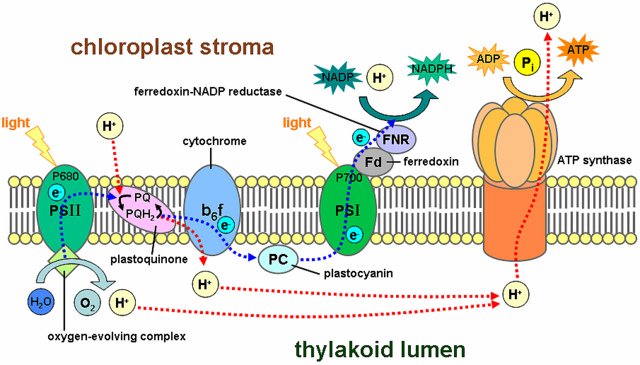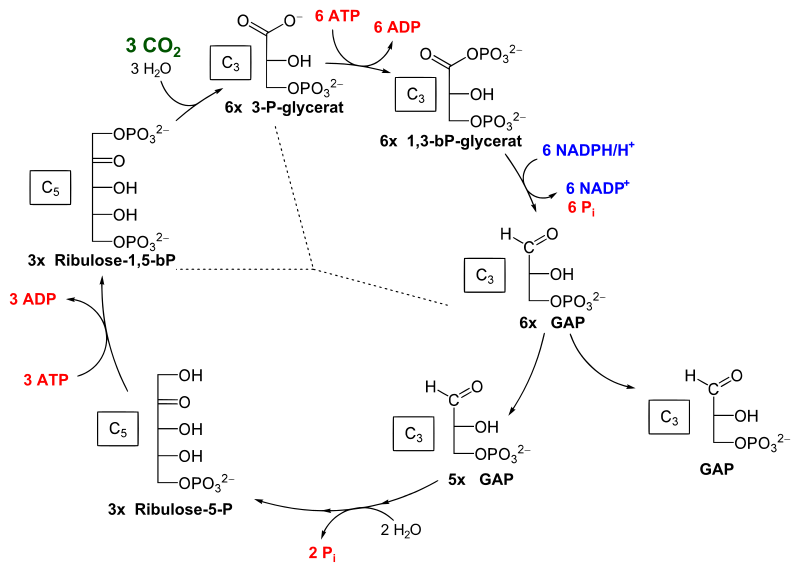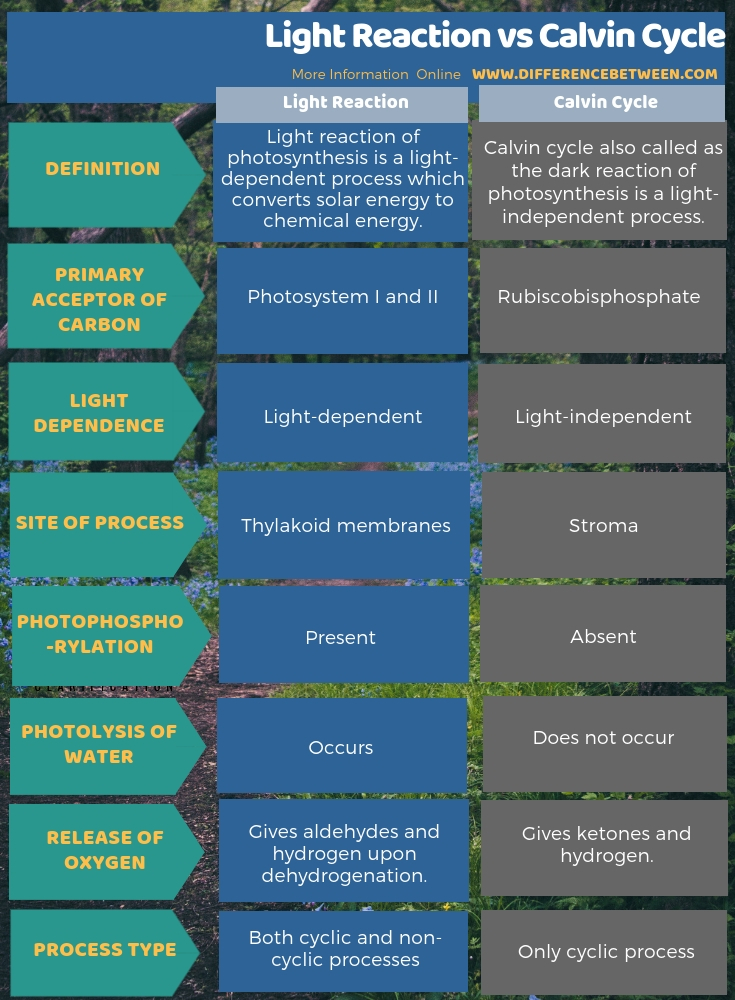Difference Between Light Reaction and Calvin Cycle
The key difference between light reaction and Calvin cycle is the dependence of light in each type of reaction in photosynthesis. Light reaction in photosynthesis is light-dependent whereas the Calvin cycle (or dark reaction in photosynthesis) is light-independent.
Photosynthesis is an autotrophic mode of nutrition occurring in plants and other photosynthetic organisms such as algae and cyanobacteria. It is an anabolic process of producing food. Photosynthesis in plants takes place in two main procedures. They are the light reaction process and the Calvin cycle. The light reaction of photosynthesis is a light-dependent process which converts solar energy into chemical energy. In contrast, the Calvin cycle also called the dark reaction of photosynthesis is a light-independent process.
CONTENTS
1. Overview and Key Difference
2. What is Light Reaction in Photosynthesis
3. What is Calvin Cycle (Dark Reaction in Photosynthesis)
4. Similarities Between Light Reaction and Calvin Cycle
5. Side by Side Comparison – Light Reaction vs Calvin Cycle in Tabular Form
6. Summary
What is Light Reaction?
Light reactions of photosynthesis take place in the thylakoid membranes of chloroplasts. They are light-dependent reactions. They convert solar energy to chemical energy via the action of chlorophyll. There are two photosystems involved in light reactions. Namely, they are photosystem I and photosystem II. Photosystems absorb light from solar energy sources. They absorb different wavelengths in light. Afterwards, the electrons in the photosystems absorb this energy and get excited. The electron acceptors accept these energized electrons.

Figure 01: Light Reaction
Hence, through the transfer of electrons, phosphorylation takes place to produce adenosine tri phosphate (ATP). Since this process is light dependent, it is known as Photophosphorylation. In addition to this, water involves in the process. This is known as photolysis of water which gives free oxygen and hydrogen ions. The hydrogen ion gradient is important in the phosphorylation process to create an electro chemical gradient. Light reaction of photosynthesis has two categories cyclic reactions and non-cyclic reactions.
What is Calvin Cycle (Dark Reaction in Photosynthesis)?
Calvin cycle also referred to as dark reaction of photosynthesis is a light independent reaction. They take place in the stroma of the chloroplast. Accordingly, the formation of sugar compounds with carbon-dioxide as the starting compound drives Calvin cycle. However, there is no activation of electrons in the Calvin cycle. Inorganic carbon that exists as carbon-dioxide fixes in the Calvin cycle to form triose sugars. They are energy dependent reactions. There are three main phases of the Calvin cycle; they are the carbon fixation, reduction, and regeneration of the starting carbon compound.

Figure 02: Calvin Cycle
The first carbon acceptor in the light-independent reactions is the 5 carbon sugar known as Rubisco bisphosphate (RuBP). The six carbon compound formed thus splits into two three-carbon molecules known as Phosphoglyceric acid (PGA). PGA then splits to produce glyceraldehyde – 3 – phosphate and regenerates RuBP. The produced glyceraldehyde – 3 – phosphate is thus used to produce glucose. Furthermore, there are two main types of dark reactions. They are the C3 pathway that takes place in C3 plants and the C4 pathway which takes place in C4 plants.
What are the Similarities Between Light Reaction and Calvin Cycle?
- Both processes produce energy in the form of ATP.
- Also, both are enzyme-mediated.
- Furthermore, both take place in chloroplasts.
- Moreover, both processes take place in autotrophic organisms.
What is the Difference Between Light Reaction and Calvin Cycle?
Light reaction in photosynthesis depends on the light energy while Calvin cycle (or dark reaction in photosynthesis) does not depend on the light energy. Therefore, tis is the key difference between light reaction and Calvin cycle. Further difference between light reaction and Calvin cycle is that the light reaction takes place in the thylakoid membrane while the Calvin cycle occurs in the stroma of the chloroplast.
Moreover, there is a difference between light reaction and Calvin cycle in the end products too. That is; the end products of the light reaction are ATP and NADPH while the end product of Calvin cycle is glucose. The below infographic on difference between light reaction and Calvin cycle provides more differences between both reactions.

Summary – Light Reaction vs Calvin Cycle
Photosynthesis occurs in photoautotrophic organisms. There are two types of photosynthesis based on their dependence to light such as light-dependent reactions and light-independent reactions. Accordingly, light-independent reactions are also called the Calvin cycle. On the other hand, light-dependent reactions take place through the involvement of photosystems. Thus, it takes place in the thylakoid membranes of the chloroplast. In contrast, the Calvin cycle takes place via the formation of organic compounds. Accordingly, this takes place in the stroma of the chloroplast. This is the difference between light reaction and Calvin cycle.
Reference:
1.“The Light-Dependent Reactions.” Khan Academy, Khan Academy. Available here
2.“The Calvin Cycle.” Khan Academy, Khan Academy. Available here
Image Courtesy:
1.”4619809768″ by BlueRidgeKitties (CC BY 2.0) via Flickr
2.”Calvin cycle”By Yikrazuul – Own work, (CC BY-SA 3.0) via Commons Wikimedia
ncG1vNJzZmivp6x7pbXFn5yrnZ6YsqOx07CcnqZemLyue8OinZ%2Bdopq7pLGMm5ytr5Wau264yKCfrWWimq6kwMiopWaZnpl6pK3Lr6CnZZOusK2xjg%3D%3D